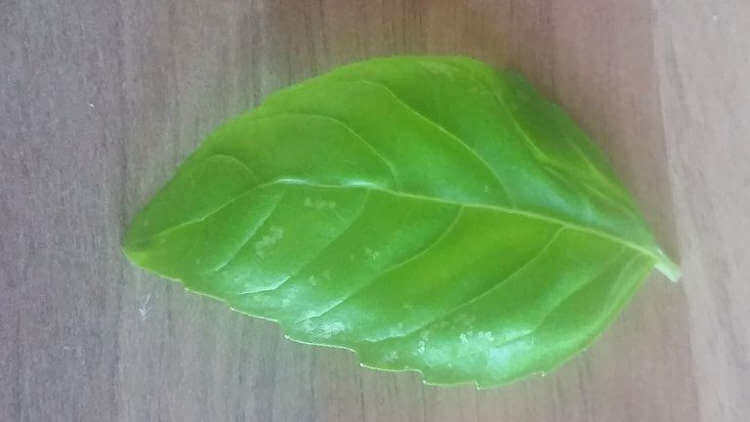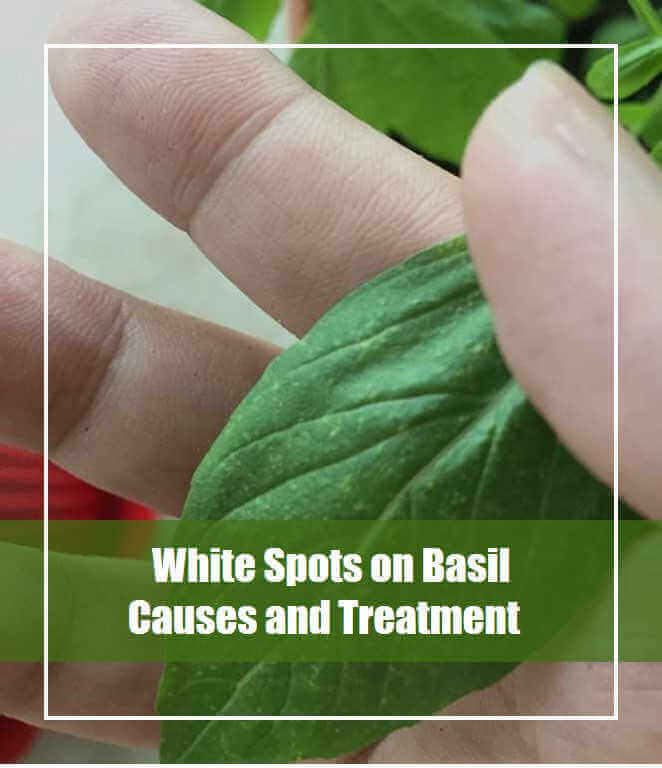You are here which means you have found white spots on basil leaves and stems. Now a lot of questions are revolving into your head. What has happened to my basil? How to remove the white spots? Is it safe to eat? etc.
Basil is the most growing vegetables all over the world. Generally, basil can overcome different plant problems by itself. But it also needs some care to prevent some diseases or problems like white or yellow spots on basil.
Listen:
Before taking any steps, you should know what the main cause of it is. Sometimes white spots on herb are so common. No need to take any action. Sometimes nutrient deficiency, insects, diseases (powdery mildew), cultural problems, or weather conditions may cause white spots on basil.
This article will help you to identify the exact reason for this problem and its solution.
Let’s get started-
What Will Happen If Basil Leaves occupy with White Spots?
At the very beginning, white patches show on the leaves edge. Day by day it increases and occupies the whole leaves. Too much white stuff on plants can decrease the photosynthesis rate that stunts plant growth. After a few days, leaves lose chlorophyll, turn yellow and the plant dies.
The Possible Reasons for White Spots on Basil & Treatment

1# Insects and Pests
The insect may be the cause of white spots on basil leaves, Aphids, Thrips (western flower thrips), whiteflies, red spider mites, leafhoppers, and mealybugs are the main culprit for it. They have the sucking type of mouthparts. They suck the plant sap and withdraw plant liquid. That’s why tiny white spots appear on leaves.
The leaves have been recently nibbled appear white dots, and earlier nibbled leaves appear black dots.
How do we know it’s for insects?
Generally, you will find that insects under the leaves. But sometimes they can’t be found under the leaves and even the plant. You have to observe carefully.
If you make sure that the problem for insects, pick off the affected leaves and rinse off the remain leaves softly with water. Then apply insecticidal soap on the basil plants in the evening. Here is the recommended insecticidal soap to remove the insect from your basil plants-
- Safer Brand 5118 Insect Killing Soap: Mix 4 tablespoons with 1 quart of water and apply.
- Natria 706230A Insecticidal Soap: Shake the solution and apply.
2# White Fungus
The fungus also can be the cause of white spots on basil. The fungus develops and spreads when the weather is wet and damp.
To get rid of fungus on basil leaves-
Remove the affected leaves, make sure enough sunlight and air circulation and lastly apply potassium bicarbonate, baking soda, or organic fungicide (keep reading to know how to apply).
3# Powdery Mildew
The white spots on basil leaves may be the sign of powdery mildew. If the white spots are fuzzy, then it is powdery mildew.
Powdery mildew can be the cause of fungus that develops in hot and humid or cold weather.
How can you treat powdery mildew on basil leaves?
You can treat powdery mildew in different ways. Here I have discussed different organic methods to treat powdery mildew-
Neem Oil
Neem oil can kill fungus in less than 24 hours. It also acts as an effective insecticide. Insect carries the fungus spore. So neem oil can be an effective preventive treatment for the powdery mildew of basil. Here is the recommended neem oil for your plants– Bonide (BND022) – Ready to Use Neem Oil
How to apply neem oil?
- Mix 3 tablespoons neem oil with 1 gallon of water.
- Wait for 1 or 2 weeks.
- Spray the solution on the plants.
Don’t spray the solution in full sun. The excess sun can burn the plant. The early evening is the best time to apply neem oil on the plant.
Insecticidal Soap
Insecticidal soap contains potassium-based fatty acids that can kill fungus as well as an insect. Purchase an organic insecticidal soap (Our pick: Safer Brand 5118 Insect Killing Soap). Mix 4 tablespoons of soap in 1 quart of water and apply on the upper and back sides of leaves in the evening.
Baking Soda, Vegetable Oil with Soapy Water
It is the most effective controlling measure of powdery mildew. Most of the organic gardeners use baking soda (Our pick: Arm & Hammer Baking Soda) to control Powdery mildew. It creates alkaline whether that kills the fungus.
Mix 1 teaspoon of baking soda with 1 liter of water. Add 1 teaspoon of vegetable oil and liquid dish soap into the solution. Shake it well and spray it on the affected plants.
Potassium Bicarbonate
Potassium bicarbonate (Our pick: Potassium Bicarbonate 2 oz) is a safe and effective method to get rid of the fungus. Potassium bicarbonate is highly alkaline in nature (pH above 8.3). The alkaline environment is not suitable for growing fungus. So fungus can’t grow and lastly, they die.
How to apply potassium bicarbonate?
- Mix 3 tablespoons of potassium bicarbonate, 3 tablespoons of vegetable oil, and ½ tablespoon of natural liquid soap with 1-gallon water.
- Shake well and pour the solution into the spray bottle.
- Spray the solution in the evening when the temperature is low.
Vinegar
Vinger (Our pick: 30% Pure Vinegar) has 5% acetic acid that can kill the germs. But you should consider the concentration of vinegar. High concentrations can burn the plant leaves.
To treat the plant with vinegar-
- Mix 4 tablespoons vinegar with 1 gallon of water.
- Spray on the plant after 3 days interval.
Milk
Do you need an instant organic method to treat your basil plant? Here is your deal
Mix 40% milk with 60% water and spray the plant 2 times in a week. You can also apply milk without mixing water to get an effective result.
Sulfur
Sulfur is a natural fungicide that can kill fungus as well as an insect. Buy a sulfur fungicide (Our pick: Soil Sul Liquid Sulfur) and apply it by following the dosing direction. Wear protective gear (mask, gloves, sunglass) before apply.
Copper Fungicides
Copper (Our pick: BONIDE Ready-to-Use Copper Fungicide) is another effective fungicides. Before apply strictly follow the dosing recommendation. Overdose can be damage to the plant and soil.
Cautions: At first, apply these solutions and fungicides on the small portion of a leaf. If you don’t notice any burn sign, then apply the whole plant. The high concentration of these solutions can burn the plant. Mix more water if you notice the plant leaves burn and must spray water before applying the solution and repeat the treatment every 10 to 14 days if required.
4# Lack of Required Weather
Wet and damp weather can cause different kinds of diseases of basil plants (powdery mildew, leaf spot, etc). Powdery mildew forms on basil when foliage is dry, lighting is low and high humidity.
Always choose a sunny and airy area to grow basil. If your basil plants in the container or pot, change the position that they can get extra air and sun.
Basil is a warm loving plant. It is very hard to grow in winter. That’s why you can grow more basil before winter. Cut and store them in the freezer for future use.
5# Cultural Problems
Over fertilizer, insufficient irrigation also can be the reason for white spots on basil leaves.
Proper fertilization and irrigation should be established to withstand this problem.
Quick Tips for Treat White Spots on Basil
If you can’t find out what reason behind the white spots, then prune the plants and apply insecticidal soap.
- Safer Brand 5118 Insect Killing Soap: Mix 4 tablespoons with 1 quart of water and apply.
- Natria 706230A Insecticidal Soap: Shake the solution and apply.
You can also make insecticidal soap at home. But be careful about the concentration. Because excess soap can burn the plant.
Preventive Treatment
- Remove the lower leaves of the basil plant that increases the air circulation and help to get more sunlight.
- Avoid full shady places to grow basil plants.
- Basil seed should be treated with hot water.
- Good spacing, enough light, and proper drainage should be maintained.
- Try to remove the affected leaves as soon as possible.
Is It Safe To Eat Basil Leaves With White Spots?
It is safe to eat basil with white spots on leaves. Wash well with hot water before eating. You can cut out if the small white spots are few, the rest of the leaf should be fine to eat.
Conclusion
I hope you have got your solution. I have tried to discuss every possible reason and solution to get rid of white spots on basil.
Some basil has spotty leaves, but they maintain a pattern. If the spots don’t increase or spread, don’t take any unnecessary action.
Let us know what was the reason for white spots on your basil plants and how you treated. Don’t forget that your past experience can help others!

